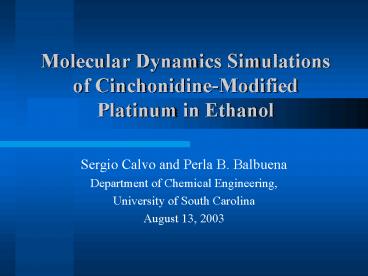Molecular Dynamics Simulations of CinchonidineModified Platinum in Ethanol - PowerPoint PPT Presentation
1 / 17
Title: Molecular Dynamics Simulations of CinchonidineModified Platinum in Ethanol
1
Molecular Dynamics Simulations of
Cinchonidine-Modified Platinum in Ethanol
- Sergio Calvo and Perla B. Balbuena
- Department of Chemical Engineering,
- University of South Carolina
- August 13, 2003
2
Outline
- Introduction
- Methodology
- Geometry Optimization Results (DFT)
- Conformation of Cinchonidine
- Dihedrals of the chiral Carbon
- Molecular Dynamics Results
- Cinchonidine adsorption in Vacuum
- Cinchonidine adsorption in ethanol
- Comparison with in-situ vibrational studies
- Conclusions
(C19H22N2O)
3
Introduction
- One of the most successful heterogeneous
enantioselective catalysts to date consists of
platinum-based materials modified by cinchona
alkaloid ligands in solution.
(C19H22N2O)
- The most well studied of these is the
hydrogenation of a-ketoesters to the
corresponding enantiopure lactates over platinum.
4
Enantioselective hydrogenation of ethyl pyruvate
using cinchonidine-platinum catalyst
- When trace amounts of cinchonidine are present in
the reacting mixture, the hydrogenation becomes
highly enantioselective towards the (R)-ethyl
lactate product and the rate of reaction is
dramatically increased.
5
Methodology
- Molecular dynamics (MD) simulations of
cinchonidine (C19H22N2O) on Pt (111) were
performed using the program DL Poly 2.13. - DREIDING force field was employed to describe
the pair interactions among cinchonidine,
platinum, and ethanol. - The overall potential energy is written as
- V(r) Vb V? V? Vi Vel Vvdw
6
Methodology
- Cinchonidine molecules 1 , 8
- Ethanol molecules 133
- (0.791 gr/cm3 _at_ 298 K )
- Platinum atoms 240
- Temperature 298K
- Equilibration Steps 300 ps
- Total production time 600 ps
- Cutoff 10 Å
Simulation Box (2.23 x 2.41 x 3.00 nm)
7
Lennard-Jones Parameters
C_R and N_R are carbon and nitrogen of the
quinoline group respectively
8
Conformation of Cinchonidine
- Several studies have been oriented to determine
the conformation of cinchonidine, using
semi-empirical methods, with restrictions in the
molecular geometry, such as imposing rigid
quinoline and quinuclidine fragments - In this work, we fully optimized cinchonidine
without any constrains. - Hartree Fock and DFT calculations were employed
- It is known that the two dihedral angles T1
(formed by 3, 4, 9, and 8) and T2 (formed by
4, 9, 8, and 1), shown in Figure 2, are relevant
for the stable conformation of cinchonidine.
9
Molecular Mechanics
Optimized structure (B3PW91/6-311G) of
cinchonidine. Purple spheres are nitrogen
atoms, black spheres carbon atoms, white
spheres hydrogen atoms, and the red sphere is
the oxygen atom.
10
Cinchonidine Adsorption on Pt(111) in Vacuum
- The interactions between cinchonidine and Pt
(111) at 298.15 K were analyzed using two
different initial configurations. - In both cases we found that the quinoline ring is
adsorbed parallel to the surface of platinum (via
the ? system). - These results are in agreement with several
experimental observations. - Also the vinyl part of the cinchonidine (double
bond) is adsorbed to the surface. - The energies of cinchonidine adsorbed on the
platinum (111) surface were examined. - EPt(111)-cinchonidine EPt(111) cinchonidine
E Pt(111) Ecinchonidine
11
Cinchonidine Adsorption on Pt(111) in Vacuum
The average values for the interaction
platinum-cinchonidine, from the equilibration
time (300ps) to 600ps is -3720.1 kcal/mol
The average value for the last 10 ps of these MD
simulations of the dihedrals T1 and T2 is 70.19º
and 137.53º
12
Cinchonidine Adsorption on Pt(111) in Ethanol
- We use two different concentrations of
cinchonidine in ethanol 0.1294 M and 1.0349 M - These MD simulations were done at 298.15K for 600
ps for all the cases. - In both cases we found that either the quinoline
group or part of the quinoline group is attached
to the platinum surface (via the ? system). - From the analysis of the radial distribution
functions of the hydrogen, carbon, and nitrogen
atom of the quinoline group (which are attached
to the platinum surface) and the platinum atoms
of the surface for the two concentrations, we
found that the shortest distance between Pt (111)
and cinchonidine is 2.125 Å .
13
Cinchonidine Adsorption on Pt(111) in Ethanol
14
Cinchonidine Adsorption on Pt(111) in Ethanol
- The result reveal that the more stable
conformations correspond to the second case
because of the most negative value of the energy
of the system. - In vacuum the quinoline group and the vinyl group
is always parallel aligned to the platinum
surface because of the most negative value for
the interaction platinum-cinchonidine. - The interaction energy of cinchonidine and
platinum is - -3679.98 kcal/mol, which is lower than the
interaction energy for the case of vacuum.
15
Comparisons with In-situ Vibrational Studies
- In this part of the study we describe in detail a
conformational structure of cinchonidine using
both ab initio (DFT) and molecular dynamics, and
experimental results. - We evaluated the IR vibrational frequencies
(B3PW91/6-31G).
16
Comparisons with In-situ Vibrational Studies
In order to compare the experimental results with
the MD simulations done in this work, we use the
DOS spectrum of cinchonidine (includes all
vibrations) in ethanol calculated from the MD
simulation data.
17
Conclusions
- The results of this study suggest that the
modifier is anchored to the surface through both
a ?-bond with the aromatic ring structure, as
well as through some degree of sigma bonding with
the aromatic nitrogen. - The results reveal a difference in the adsorption
of the cinchonidine on the platinum surface with
respect to the case of vacuum. In vacuum the
quinoline group and the vinyl group is always
parallel aligned to the platinum surface because
of the most negative value for the interaction
platinum-cinchonidine. - The comparison of the experimental results and
the MD simulations indicates some agreement in
the mechanism of the adsorption of cinchonidine
on platinum surfaces.































